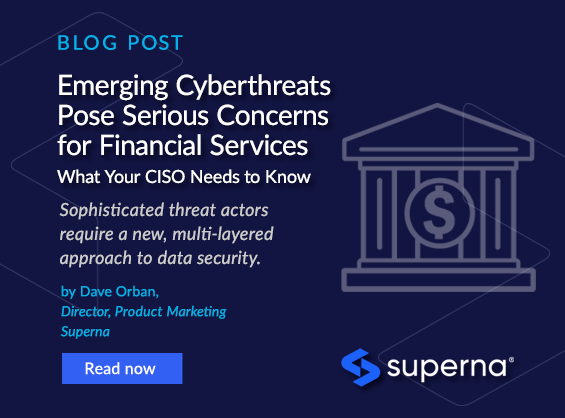Emerging cyberthreats pose serious concerns for Financial Services: What your CISO needs to know
- Date: Aug 22, 2024
- Read time: 8 minutes

Sophisticated threat actors require a new, multi-layered approach to data security.
Digital transformation in the global financial services industry, along with heightened geopolitical tensions, have greatly increased the risk of cyberattack. The risk of extreme losses from cyber incidents continues to increase, having more than quadrupled since 2017 to more than $2.5 billion annually.
The massive amount of sensitive data and transactions they handle makes them prime targets for criminals looking to steal money, extort, or otherwise disrupt economic activity. Attacks on these institutions have the potential to erode confidence in the financial system, disrupt critical services, even cause spillovers to other institutions. Attacks on financial services firms account for nearly one-fifth of the global total, of which banks tend to be the most exploited. Financial services firms rely increasingly on third-party IT service providers. While these external providers can help improve operational resilience, they can also expose the financial industry to systemwide shocks. For example, a 2023 ransomware attack on a cloud IT service provider caused simultaneous outages at 60 U.S credit unions.
The financial services sector faces a wide range of cyber risks, including:
- Cyberattacks like ransomware, trojans, spoofing, SQL injections, cross-site scripting, local file inclusion, OGNL Java injections, and DDoS attacks.
- Increasingly sophisticated Social Engineering attacks, frequently bolstered by AI.
- Supply chain attacks, including third-party and supply chain management targets.
- Insider threats including business email compromise (BEC).
- Cloud security threats attacking emerging technologies, which can introduce new cyber risks
When it comes to data breaches, ransomware, and extortion, the risk is real. The number of respondents to a recent survey who had their data and systems held hostage rose from 35% in 2022 to 42% in 2024. And cyber extortion – a ransomware tactic that involves stealing and threatening to publicly release company data – is now more common than ransomware itself. Forty-eight percent of respondents say they experienced cyber extortion, compared to 45% who were ransomware victims. To compound things, a recent cyber resilience research commissioned by data security solution provider Cohesity revealed that many organizations overestimate their cyber resilience capabilities, which can lead to significant business continuity disruptions and even ransom payments.
Part of the problem is that as technologies evolve, so too does the nature of cyber threats, becoming more aggressive – and sophisticated – every day. Add-in the massive data growth fueled by the rapid adoption of Artificial Intelligence (AI) and Machine Learning (ML), and now the available attack surface has quadrupled, with no end in sight. Both the inputs and outputs of AI and ML are comprised almost entirely of unstructured data, for which many traditional backup and recovery solutions prove to be woefully inadequate.
Data Security Fundamentals
Some simple steps you can take to bolster your data security posture include:
- Regular security training. A properly-trained employee is far less likely to make errors in judgment that can result in a security breach. The employees at many organizations review security policies and/or receive security awareness training less than once a year. Given the speed with which new security threats emerge, it’s important that your employees know what to look for, and what steps to take in the event of a possible intrusion.
- Strong, credential-based authentication. Limit, control, and monitor physical and digital access to spaces, assets, and data. Provide your authorized users with high-assurance, credential-based authentication that allows them to quickly and easily authenticate their identity and confirm their access privileges.
- Digital certificates. A robust digital certificate program can complement strong authentication in confirming the identity of a user, device, or server.
- Data protection. Sensitive customer information – including Social Security numbers and financial information – should be encrypted – both at-rest and in transit.
- Secure critical infrastructure. The ways in which critical infrastructure can become insecure are numerous. As just one example, consider software patch management. Out of the more than 600 incident response cases monitored last year by Palo Alto Network’s Unit 42, poor patch management contributed to an astonishing 28% of all successful breaches!
The solution? A layered approach to data security, utilizing multiple security measures, policies, and solutions to safeguard an organization’s IT environment from cyberattacks and data leaks. The goal is simple: Make it more difficult for a threat actor to get through the network perimeter, steal sensitive data, and impact your infrastructure. Of course, even the best security perimeter can be breached, and typically as a result of human error: Phishing, overly-simplistic passwords, shared credentials, and so on. And once breached, a bad actor can run rampant in your network, poking and prodding, testing your defenses and looking for their ultimate prize: Your data.
Protecting the perimeter is no longer enough
Modern attack surfaces are inherently dynamic and constantly shifting, moving and growing over time. This is particularly true of unstructured data, with explosive growth fueled by the rapid adoption of Artificial Intelligence (AI) and Machine Learning (ML). Attackers are becoming increasingly adept at scanning the internet in search of vulnerable systems and exploiting gaps in security before they can be patched. Given the multitude of ways in which a bad actor can make their way into your network, the traditional, perimeter-based approach to data security is no longer adequate. A layered approach to data security is rapidly becoming the new gold standard for data protection.
What is a Layered Security Strategy?
In layered security, each element plays a distinct role in safeguarding against threats. In the simplest terms, it uses multiple security measures simultaneously to protect your digital assets. The presumption is that no single security measure by itself is adequate. By employing different types of security tools and methods, you can create a much stronger system of defenses. In the context of cybersecurity, this might include physical measures like secure access to buildings; and organizational policies that mandate strong passwords for employees; along with technology tools like firewalls and malware detection software. Each layer is designed to address different types of threats or provide additional barriers to potential attackers. And if one layer fails, others remain in place to help keep your critical data safe. Properly conceived and deployed, it’s a dynamic defense strategy that continually evolves to meet the challenges posed by new threats, helping to mitigate risk and minimize business disruption.
Security at the Data Layer
As data growth continues to expand the storage footprint, it creates a much larger attack surface, one in which traditional perimeter safeguards are no longer sufficient. Data layer security is the monitoring of actual data packets in order to detect – and respond to – attempts to compromise networks and applications. Keeping a record of everything that happens on your site can be invaluable, especially after a security incident. An activity log can track changes, logins, and updates, making it easier to pinpoint how and when a breach occurred. This insight can both guide your response and help strengthen your defenses against future attacks.
Superna’s approach to security is unlike that of a typical data protection solution. Even in the event of a perimeter breach, Superna software remains alive and well, protecting the data at its source. And while endpoint protection and traditional backup and recovery solutions are critical, the value of a multi-layered approach to data security is clear. Superna runs in a controlled deployment inside the datacenter and is complementary to the traditional backup and recovery solutions that are commonly in use today. So, in scenarios in which endpoint security was compromised, Superna solutions remain unaffected, running in the background, monitoring and analyzing data access, and can spring into action as necessary. By continuing to secure the data, it enables a quicker return to normal business operations. And Superna’s robust integration with leading SIEM and SOAR tools means that you can monitor and manage your Superna deployment from within the security tools you already use!
Key Takeaways
- Driven by modern, machine-generated workloads typical in financial services organizations, the amount of unstructured data continues to grow at an astonishing pace. Complex and siloed legacy storage platforms often struggle to meet the demands of securing that data.
- This unprecedented growth of business-critical data requires a simple, scalable high-performance solution to both secure and maximize the business value of your file and object data.
- When coupled with industry-leading storage platforms, Superna can help financial services organizations achieve robust cyber resilience, informed by the best practices outlined in the NIST Cybersecurity Framework, the global benchmark for cybersecurity.
Prevention is the New Recovery
For more than a decade, Superna has provided innovation and leadership in data security and cyberstorage solutions for unstructured data, both on-premise and in the hybrid cloud. Superna solutions are utilized by thousands of organizations globally, helping them to close the data security gap by providing automated, next-generation cyber defense at the data layer.
By focusing on data security at the core, Superna helps ensure that even if your endpoint defenses are compromised, critical data remains protected. This layered approach to data security helps financial services organizations safeguard their most valuable asset – their data – against both cyberthreats and human error, for improved resilience and business continuity in a world that is increasingly reliant on data. And through robust integrations with industry-leading SIEM and SOAR tools, Superna allows you to monitor and manage your file and object data using the security tools you already have in place.
Superna is recognized by Gartner as a solution provider in the cyberstorage category. Superna… because prevention is the new recovery!
Featured Resources

Mastering Cybersecurity Insurance Negotiations: A Comprehensive Guide

Navigating the Digital Menace: A Beginner’s Guide to Ransomware
